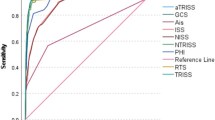Abstract
Objectives
Injury severity scoring tools allow systematic comparison of outcomes in trauma research and quality improvement by indexing an expected mortality risk for certain injuries. This study investigated the predictive value of the empirically derived ICD9-derived Injury Severity Score (ICISS) compared to expert consensus-derived scoring systems for trauma mortality in a pediatric population.
Methods
1935 consecutive trauma patients aged <18 years from 1/2000 to 12/2012 were reviewed. Mechanism of injury (MOI), Injury Severity Score (ISS), Revised Trauma Score (RTS), Trauma Score ISS (TRISS), and ICISS were compared using univariate and multivariate logistic regression analysis and receiver operator characteristic analysis.
Results
The population was a median age of 11 ± 6 year, 70 % male, and 76 % blunt injury. Median ISS 13 ± 12 and overall mortality 3.5 %. Independent predictors of mortality were initial hematocrit [odds ratio (OR) 0.83 (0.73–0.95)], HCO3 [OR 0.82 (0.67–0.98)], Glasgow Coma Scale score [OR 0.75 (0.62–0.90)], and ISS [OR 1.10 (1.04–1.15)]. TRISS was superior to ICISS in predicting survival [area under receiver operator curve: 0.992 (0.982–1.000) vs 0.888 (0.838–0.938)].
Conclusions
ICISS was inferior to existing injury scoring tools at predicting mortality in pediatric trauma patients.

Similar content being viewed by others
References
Bernard SJ, Paulozzi LJ, Wallace DL et al (2007) Fatal injuries among children by race and ethnicity–United States, 1999–2002. MMWR Surveill Summ 56(5):1–16
Inon AE, Haller JA Jr (2002) Caring for the injured children of our world: a global perspective. Surgical Clin North Am 82(2):435–445
Allen CJ, Teisch LF, Meizoso JP et al (2015) Prehospital care and transportation of pediatric trauma patients. J Surg Res 197:240–246
Hughes NT, Burd RS, Teach SJ (2014) Damage control resuscitation: permissive hypotension and massive transfusion protocols. Pediatr Emerg Care 30(9):651–656
Committee on Medical Aspects of Automotive Safety (1971) Rating the severity of tissue damage. I. The abbreviated scale. JAMA 215(2):277–280
Osler T, Rutledge R, Deis J et al (1996) ICISS: an international classification of disease-9 based injury severity score. J Trauma 41(3):380–386 (discussion 386–8)
Baker SP, O’Neill B, Haddon W Jr et al (1974) The injury severity score: a method for describing patients with multiple injuries and evaluating emergency care. J Trauma 14(3):187–196
Champion HR, Sacco WJ, Copes WS et al (1989) A revision of the Trauma Score. J Trauma 29(5):623–629
Senkowski CK, McKenney MG (1999) Trauma scoring systems: a review. J Am Coll Surg 189(5):491–503
Champion HR, Copes WS, Sacco WJ et al (1996) Improved predictions from a severity characterization of trauma (ASCOT) over Trauma and Injury Severity Score (TRISS): results of an independent evaluation. J Trauma 40(1):42–48 (discussion 48–9)
Rutledge R, Fakhry S, Baker C et al (1993) Injury severity grading in trauma patients: a simplified technique based upon ICD-9 coding. J Trauma 35(4):497–506
Champion HR, Sacco WJ, Lepper RL et al (1980) An anatomic index of injury severity. J Trauma 20(3):197–202
Chawda MN, Hildebrand F, Pape HC et al (2004) Predicting outcome after multiple trauma: which scoring system? Injury 35(4):347–358
Leaphart CL, Graham D, Pieper P et al (2009) Surgical quality improvement: a simplified method to apply national standards to pediatric trauma care. J Pediatr Surg 44(1):156–159
Boyd CR, Tolson MA, Copes WS (1987) Evaluating trauma care: the TRISS method. Trauma Score and the Injury Severity Score. J Trauma 27(4):370–378
Tepas JJ, Leaphart CL, Celso BG et al (2008) Risk stratification simplified: the worst injury predicts mortality for the injured children. J Trauma 65(6):1258–1261 (discussion 1261–3)
Notrica DM, Weiss J, Garcia-Filion P et al (2012) Pediatric trauma centers: correlation of ACS-verified trauma centers with CDC statewide pediatric mortality rates. J Trauma Acute Care Surg 73(3):566–570 (discussion 570–2)
Centers for Disease Control and Prevention (CDC) (1997) Rates of homicide, suicide, and firearm-related death among children–26 industrialized countries. MMWR Morb Mortal Wkly Rep 46(5):101–105
Allen CJ, Straker RJ, Tashiro J et al (2015) Pediatric vascular injury: experience of a level 1 trauma center. J Surg Res 196(1):1–7
Allen CJ, Tashiro J, Valle EJ et al (2014) Initial hematocrit predicts the use of blood transfusion in the pediatric trauma patient. J Pediatr Surg 49(11):1678–1682
Allen CJ, Valle EJ, Thorson CM et al (2015) Pediatric emergency department thoracotomy: a large case series and systematic review. J Pediatr Surg 50(1):177–181
Rutledge R, Hoyt DB, Eastman AB et al (1997) Comparison of the Injury Severity Score and ICD-9 diagnosis codes as predictors of outcome in injury: analysis of 44,032 patients. J Trauma 42(3):477–487 (discussion 487–9)
Guzzo JL, Bochicchio GV, Napolitano LM et al (2005) Prediction of outcomes in trauma: anatomic or physiologic parameters? J Am Coll Surg 201(6):891–897
Offner PJ, Jurkovich GJ, Gurney J et al (1992) Revision of TRISS for intubated patients. J Trauma 32(1):32–35
Moore L, Lavoie A, Abdous B et al (2006) Unification of the revised trauma score. J Trauma 61(3):718–722 (discussion 722)
Morris JA Jr, MacKenzie EJ, Edelstein SL (1990) The effect of preexisting conditions on mortality in trauma patients. JAMA 263(14):1942–1946
Acknowledgments
We would like to thank Jonathan Andron, who maintains the trauma registry.
Author information
Authors and Affiliations
Corresponding author
Ethics declarations
Conflicts of interest
None of the authors have declared conflicts of interest.
Rights and permissions
About this article
Cite this article
Allen, C.J., Wagenaar, A.E., Horkan, D.B. et al. Predictors of mortality in pediatric trauma: experiences of a level 1 trauma center and an assessment of the International Classification Injury Severity Score (ICISS). Pediatr Surg Int 32, 657–663 (2016). https://doi.org/10.1007/s00383-016-3900-7
Accepted:
Published:
Issue Date:
DOI: https://doi.org/10.1007/s00383-016-3900-7




